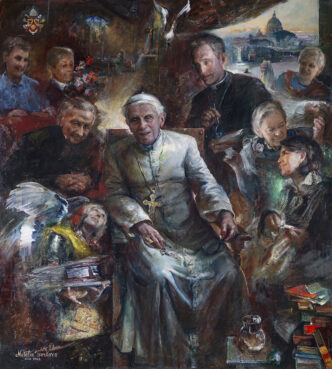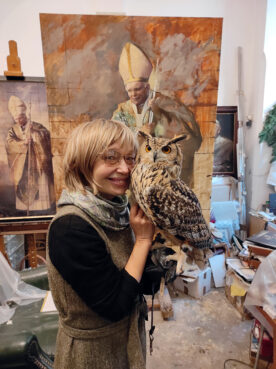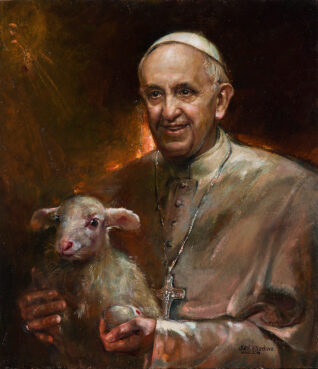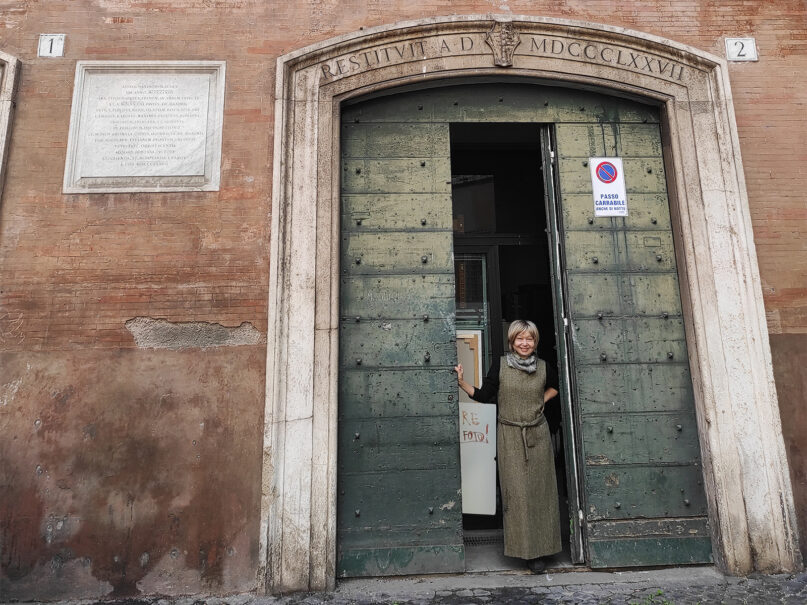VATICAN CITY (RNS) — From her cozy studio hidden behind Rome’s famous Piazza Navona, the “official Vatican portraitist,” Natalia Tsarkova, uses her brush to capture the likeness of popes, princes and patriarchs.
A 6-foot portrait of the recently canonized St. John Paul II, peering down benevolently while leaning on a shimmering staff, dominates the apartment, located in a 16th century palace. Above the door a fresco of an angel painting on a canvas remains visible despite the erosion of time.
On a recent December Friday, the pungent odor of oils and painting solutions filled the room as Rufus Majestic, a large Indian Eagle owl, circled overhead, occasionally hooting at the intrusions into his domain. Below, Tsarkova’s tiny frame moved nimbly through the collection of books, paintings and boxes strewn all over the floor as she searched for pictures of her latest project: the most recent portrait of Benedict XVI, a massive composition showing the retired pope surrounded by his pontifical family.
Dubbed the “painter of popes,” Tsarkova is the first artist to portray four of them — John Paul I and II, Benedict XVI and Pope Francis — and she approaches her work with both passion and mission, aiming to bring a message of peace to a world fraught with division and conflict.
“A painting isn’t enough. It also has to have a positive impact,” Tsarkova, who came to Rome in 1995, told Religion News Service. “I feel a great responsibility and honor through my art as an Orthodox Christian,” she added.
Born in Soviet-era Moscow, Tsarkova showed promise as an artist at a very young age. In 1989 she became the first woman to be accepted into the Russian Fine Arts Academy and studied under the mentorship of famed Russian painter Ilia Sergeevich Glazunov.
Tsarkova’s first years in Rome were marked by struggle and poverty. “But by the late 1990s, I began to see her everywhere,” said Robert Moynihan, founder and editor-in-chief of the magazine Inside the Vatican, in an email to RNS. The Vatican expert said Tsarkova “was tireless” and quickly built a network of connections at curial and diplomatic events.
“I believe that it was through these contacts that she was able eventually to receive the commissions to do portraits of high-ranking Vatican officials, and even Popes,” he said.
In 2001, when synods were markedly secretive and closed-off affairs, Tsarkova became the first woman allowed to attend the bishops’ assembly. She was present at almost every meeting and created a painting representing John Paul II’s last synod of bishops. Her art has traveled all over the world and has been showcased in sites ranging from the U.S. Congress in Washington to London, Moscow and Beirut.
She also painted a portrait of the Russian Orthodox Patriarch Kirill of Moscow in 2015, which she described as a great honor. “I try to be a bridge between Russia and the Vatican,” she said.
“The popes say to stop the fighting and remember that we have much more in common than we realize,” she said.
“I do as the popes do, I pray for peace and try to contribute as much as I can for peace with my brush,” she added. “Art is above everything.”
According to Moynihan, Tsarkova’s desire to repair the tense relations between the smallest and the largest states in the world was evident early on and continues to be relevant today.
“The events of recent years, and now the war in Ukraine, have made clear that deep, ancestral tensions and suspicions are extraordinarily difficult to overcome, but I still believe Natalia’s exceptional work in Rome will be seen in years to come as a contribution, born from the hope that animated her in the 1990s and early 2000s, to deeper understanding between the East and West, and, eventually, friendship and peace,” he said.
Her most recent isn’t Tsarkova’s first portrait of Benedict, who shocked the world when he became the first to step down as pontiff in over 500 years, but she is the only artist who has been allowed to paint the pope since his retirement. Unlike previous iterations, depicting Benedict as an immovable monolith of Catholic doctrine and morality, her latest is a more dynamic and intimate, though still powerful, portrait of the pope in the sunset of his life.
“It’s a painting that requires contemplation,” Benedict told Tsarkova when he was presented with the final result and asked that it be exhibited in a museum.

Painting by Natalia Tsarkova
In the painting, Benedict is seated among his family members and friends, aging yet smiling, bathed in the loving gaze of those who have stayed beside him — including his ginger tabby cat. Most of the cast surrounding him are women, the Memores Domini, tasked with taking care of the emeritus pope. His caregiver Carmela is portrayed sowing buttons, according to the Russian saying that sewing buttons can grant wishes. The cook, Loredana, holds a tiny menu symbolizing Benedict’s light eating habits. Rosella and Cristina take care of the household chores and the upkeep of the small chapel, which is shown glowing in heavenly light in the upper corner of the canvas.
A reflection in a glass carafe in the foreground shows the pope playing the piano, a beloved hobby of his.
Georg Gänswein, the pope’s personal secretary, is seen transcribing Benedict’s words. “The pope is speaking to us, like he wants to get up and talk to us,” Tsarkova said.
The pope’s brother, Georg Ratzinger, is shown leaning familiarly toward Benedict in the painting, “listening with joy, as if (Benedict’s) words are warming his heart and he is illuminated from within,” Tsarkova explained; she had a chance to sketch Ratzinger’s likeness when he visited the Vatican before his death in 2020.
“I would have this painting made just to be close with my brother,” the pope said after seeing the painting, according to Tsarkova.
Tsarkova, who usually inserts herself in her major commissions, used her own likeness for the Archangel Michael, who is portrayed offering a collection of Benedict’s writings. Since the painting was made while Tsarkova was in isolation during the COVID-19 pandemic, she took a selfie for inspiration.

Artist Natalia Tsarkova holds her owl, Rufus Majestic, at her studio in Rome in early December 2022. RNS photo by Claire Giangravé
“I was alone within four walls,” she said. From her window she could see the Vatican as she worked on the portrait of Benedict. “He kept me company. I would wake up and say, ‘Good morning, Holy Father!’ and ‘Good night!’ before falling asleep.” Her owl, of course, never left her side while feeding on quail eggs and baby chicks.
A quick look at the studio points to her love for large compositions. The Last Supper, showing Christ sharply turned toward the viewer and questioning who will betray him, is a massive 7 by 5 feet. St. George defeating a dragon spewing toxic waste and smog looms largely from behind plastic wrapping in the corner of the studio.
On Dec. 1, the painting of Benedict was presented at the Vatican during an award ceremony for the annual Ratzinger Prize awards, handed out to extraordinary contributors in the field of theology. Barbara Jatta, whom Pope Francis appointed to be the first woman to direct the Vatican Museums, praised Tsarkova for her ability “to combine her extraordinary technique with her incredible and original command of composition.”
Tsarkova made five portraits of John Paul II, one of John Paul I, three of Benedict XVI and one of Francis. But for the artist, each is different “in the way they carry the cross, they evangelize and spread the word.”
According to Bethany Bromwell, curator of the St. John Paul II National Shrine in Washington, D.C., Tsarkova offers “educational paintings as well as works of art.” Of all the papal portraits kept at the shrine, Bromwell’s favorite are the ones by Tsarkova, because “they depict stories.”
The shrine holds a large collection of objects and regalia connected to the life and legacy of John Paul II. A number of Tsarkova’s artworks are exhibited there, including portraits of John Paul II and Benedict XVI.
Visitors at the shrine relate the most with the “realism” and “familiarity” of Tsarkova’s art, Bromwell told RNS, adding that unlike many other Vatican artists’ “perfect and sanitized” papal portraits, she does not shy away from showing the aging fragility of the popes.
John Paul II is shown leaning on his cane, Bromwell said, adding that “he looks elderly and concerned for the future.” The small portrait of Benedict shows him “aging, but with a whisper of a smile,” something unexpected from the pope theologian, she added.
Like most portrait artists, Tsarkova hopes to portray an inner truth about her subjects. This is what she believes makes paintings different from photos. She spends a lot of time studying her subjects, Tsarkova said, from their writings to their habitat.

Painting by Natalia Tsarkova
“I need to enter their life, including their spiritual lives,” she said. Tsarkova described herself as an instrument, channeling something that does not originate from her through her brushes and sometimes directly with her hands on the canvas.
“It’s a kind of magic,” she said.
In a corner near the window of the studio hangs the portrait of Pope Francis. Orange paint gives a fiery glow to the Jesuit pontiff, who is shown holding a lamb. Tsarkova said she was inspired by Francis’ constant appeal for “pastors to have the smell of the sheep,” meaning they should be immersed in the community they serve and present in the current time.
The colors in the portrait are mainly brown, like the cassock worn by Franciscan friars, and a glimmering image of the pope’s namesake, St. Francis of Assisi, known for his love for nature and the poor, can be seen in the upper left corner of the painting.
In a private meeting, Francis blessed Tsarkova and her efforts to promote peace and Christ’s message in her art. “For me, it has become my mission,” she said, as the watchful gaze of the popes fell on her from their frames within the studio.





